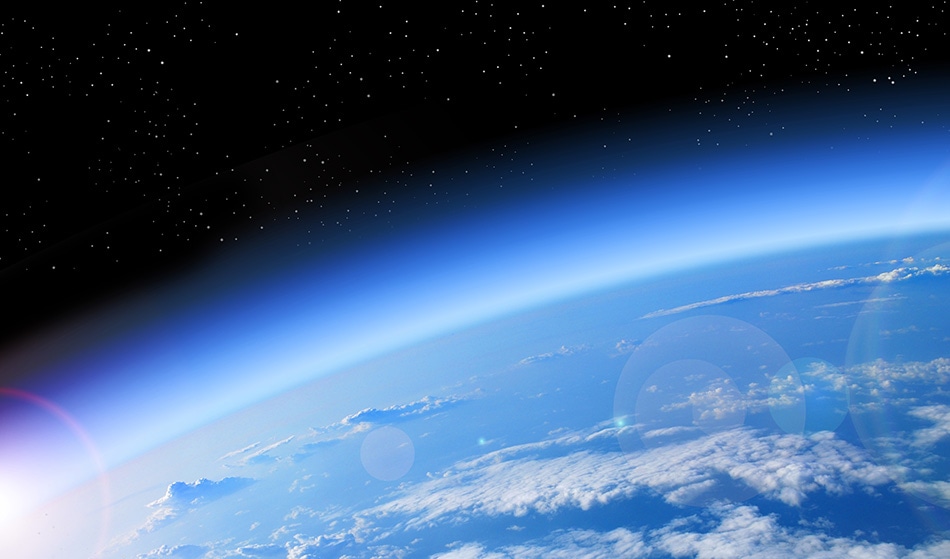Global ozone has been in decline since the 1970's and while the polar regions have been experiencing some recovery, an unexpected decrease in sections of the atmosphere could be preventing rehabilitation at lower latitudes.
Ozone is created in the stratosphere, a region above the troposphere in which we live, between 10 and 50km in altitude. The gas is produced in the tropic regions and distributed across the world; much of it sits in the lower stratosphere where it absorbs a large proportion of the Sun's UV radiation. If it hits the surface, the radiation can damage DNA in animals, plants and even humans on Earth.
 studio23/shutterstock
studio23/shutterstock
In the 1970's, it was realized that man-made chemicals called chlorofluorocarbons (CFCs), used in aerosols and refrigeration, were damaging the ozone in the stratosphere. The Montreal Protocol, signed in 1987, agreed that CFCs should be phased out – a move which has helped the ozone on the path to recovery. The Antarctic showed the first signs of rehabilitation and now the upper stratosphere at lower latitudes is showing clear signs too.
However, new research has reported that the bottom part of the ozone layer at more occupied latitudes is not recovering. Scientists from Imperial College London believe stratospheric ozone between 60N and 60S is unlikely to be recovering, due to unexpected decreases in the lower part of the stratosphere – and no one knows why.
"Ozone has been seriously declining globally since the 1980s, but while the banning of CFCs is leading to a recovery at the poles, the same does not appear to be true for the lower latitudes," says Professor Joanna Haigh, Co-Director of the Grantham Institute for Climate Change and the Environment at Imperial. “The potential for harm in lower latitudes may actually be worse than at the poles. The decreases in ozone are less than we saw at the poles before the Montreal Protocol was enacted, but UV radiation is more intense in these regions and more people live there.”
There are a number of theories about the reasons behind this decline; the first is that the pattern of atmospheric circulation may be altering due to climate change, which then causes more ozone to dissipate from the tropics.
Another hypothesis is that some very short-lived substances (VSLSs) - chemicals such as solvents and paint strippers, which contain bromine and chlorine - could be destroying the ozone in the lower stratosphere.
Dr William Ball, who led the study published in Atmospheric Chemistry and Physics, says: “The finding of declining low-latitude ozone is surprising since our current best atmospheric circulation models do not predict this effect. Very short-lived substances could be the missing factor in these models.”
It was believed that VSLSs would not remain in the atmosphere long enough to reach stratospheric heights and affect the ozone, but more research may now be required.
This study saw new algorithms developed, by combining the work of several international teams who had been correlating data from various satellite missions (1985 - present).
“The study is an example of the concerted international effort to monitor and understand what is happening with the ozone layer; many people and organizations prepared the underlying data, without which the analysis would not have been possible,” explains Dr. Ball, who is from ETH Zurich and PMOD/WRC Davos.
The decline had previously been pinpointed by individual datasets, but the application of advanced merging techniques and time series analysis has uncovered a long-term trend of decreasing ozone in the stratosphere at lower altitudes and latitudes.
Research focus should now be on getting more precise data on ozone decline and determining the most likely cause, for example by looking for the presence of VSLSs in the stratosphere, the team said.
Dr. Justin Alsing from the Flatiron Institute in New York, who had a key role in formulating and testing the statistical technique, said: “This research was only possible because of a great deal of cross-disciplinary collaboration. My field is normally cosmology, but the technique we developed can be used in any science looking at complex datasets.”
The study included researchers from Switzerland, UK, USA, Sweden, Canada and Finland, as well as data gathered by satellite missions (some carried out by NASA).
Disclaimer: The views expressed here are those of the author expressed in their private capacity and do not necessarily represent the views of AZoM.com Limited T/A AZoNetwork the owner and operator of this website. This disclaimer forms part of the Terms and conditions of use of this website.